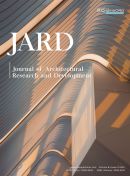Abstract
Urban subways have developed rapidly in recent years and has gradually become the primary choice of public transportation in big cities. Subways can effectively alleviate urban traffic congestion and improve passengers’ green travel experience, especially in the old urban areas where urban space is limited, community facilities are aging and historical features are gathered. Subways play a huge role in guiding the expansion of urban space form and improving urban landscape environment. As the only channel for passengers to get in and out of the station, the subway entrance and exit act as a bridge. It is not only the transition space between the subway station space and the urban above ground space, but also an important node for the exchange and circulation of various elements in the urban space. In this paper, the influencing factors of subway entrance and exit space environments in the old city were investigated, and relevant basis for future planning, design, and construction of subway entrances and exits were provided. Firstly, the research results and shortcomings of subway entrance and exit channels were outlined. Secondly, based on the perspective of residents and passengers, this paper uses the analytic hierarchy process to determine six first-class evaluation indexes, including safety, convenience, practicability and aesthetics. This paper constructs the evaluation system of spatial environment index of subway station entrances and exits in the old urban area of Xi’an. Lastly, according to the evaluation results, the paper puts forward the targeted optimization strategies for the current situation of the entrance and exit space environment of the subway stations in the Xi’an.
References
Leng H, 2012, Research on the Interaction Between Subway Entrance and Exit and Surrounding Space, dissertation, Southwest Jiaotong University.
Zhuang Y, Yuan M, 2017, Station-City Synergy: The Distribution and Performance of Space Use in Rail Station Areas, Tongji University Press, Shanghai.
Wang H, 2012, Research on Residential Space Design Along Beijing Rail Transit. Beijing University of Civil Engineering and Architecture.
Chen F, 2011, Analysis and Design of Urban Spatial Form Characterization Around Transportation Hubs in Urban Central Areas dissertation, Beijing Jiaotong University.
Liu J, 2018, Research on the Optimization of Block Space Around the Rail Transfer Station in the Main City of Chongqing, dissertation, Chongqing University.
Oliveroverbel R, Moreno T, Fernándezarribas J, et al., 2021, Organophosphate Esters in Airborne Particles from Subway Stations. The Science of the Total Environment, 769: 145105.
López-Contreras N, Puig-Barrachina V, Vives A, et al., 2021, Effects of an Urban Regeneration Program on Related Social Determinants of Health in Chile: A Pre-Post Intervention Study. Health and Place, 68: 102511.
Nielsen KS., Cologna V, Lange F, et al., 2021, The Case for Impact-Focused Environmental Psychology. https://www.doi.org/10.31234/osf.io/w39c5
Lo S–C?Chang W-J, 2012, Design of Real-Time Fuzzybus Holding System for the Mass Rapid Transit Transfer System. Expert System with Applications, 39(2): 1718–1724?
Guo S-X, Lei Y, Chen X–M, et al., 2011, Modelling Waiting Time for Passengers Transferring from Rail Tobuses. Transportation Planning and Technology, 34(8): 795–809?
Nielsen OA, Eltved M, Anderson MK, et al., 2021, Relevance of Detailed Transfer Attributes in Large-Scale Multimodal Route Choice Models for Metropolitan Public Transport Passengers. Transportation Research Part A: Policy and Practice, 147: 76–92.
Yuan F, Yuan H, Wu S, et al., 2021, A Study on the Pedestrian Accessibility of the Subway Transfer Space Based on the Empirical Analysis of Space Syntax—Taking the T2 Terminal of Chengdu Shuangliu Airport as an Example. Journal Of Housing Environment, 36(06): 83–91. https://www.doi.org/10.13791/j.cnki.hsfwest.20210611
Jiang F, 2001, Research on the Relationship Between Rail Transit Demand Forecast and Urban Passenger Transportation Hub. Transportation Systems Engineering and Information, 1(4): 311–315?
Sun L-S, Rong J, Yao L-Y?et al, 2012, Entropy-Based Estimation of Transfers in a Terminal. Transportation Planning and Technology, 35(3): 305–315.
Zhou W, Jiang C, 2005, Research on Passenger Transfer in Urban Transportation Hubs. Transportation System Engineering and Information, 5(5): 23–30.
Nie T, Zheng W, Sun Y, et al., 2019, An Evaluation Method for Passenger Transfer Service Level In A Comprehensive Passenger Hub. Transportation Research, 5(6): 4–49.
Zhao Q, 2019, Research on the Accessibility of Large Railway Passenger Station Transfer Station Hall Based on Space Syntax—Taking Nanjing South Railway Station as an Example. Urban Architecture, 16(12): 17–22. https://www.doi.org/10.19892/j.cnki.csjz.2019.12.005
Sun H, Liu W, 2019, Research on Space Line-of-Sight Optimization for Super-Large Railway Station Transfer Based on Space Syntax. Huazhong Architecture, 37(03): 50–55.10.13942/j.cnki.hzjz.2019.03.012
Hu B, Ni Z, Lv Y, 2016, Depth Map-Based Optimal Design of Subway Station Transfer Space Orientation. Urban Express Rail Transit, 29(01): 30–34.
He H, 2014, Research on the Evaluation of the Guidance Sign System of The High-Speed Railway Passenger Terminal Station, dissertation, Southwest Jiaotong University.
